Understanding Japanese Mounjaro Dessert
What is Japanese Mounjaro dessert?
Japanese Mounjaro dessert is a modern fusion pudding inspired by purin, Japan’s answer to flan. Classic purin is a custard made from eggs, milk and sugar with a bittersweet caramel layer justonecookbook.com The texture is silky and smooth and it jiggles gently when shaken justonecookbook.com In this fusion version, the creamy base is flavoured with matcha, citrus and tropical ingredients instead of caramel, then layered and topped with garnishes.
Note: This Mounjaro recipe is a Japanese-style gelatin dessert inspired by purin – not the viral Mounjaro weight-loss drink. It’s a silky, sweet pudding layered with matcha, yuzu and tropical flavours.
How the dessert differs from the viral Mounjaro drink
Many search queries for “Japanese Mounjaro” refer to a wellness drink that mixes matcha, ginger, umeboshi (pickled plum) and kombu for gut health. That four‑ingredient beverage is marketed online as a natural appetite suppressant. This recipe is not a detox drink, nor does it claim weight‑loss benefits. It is a dessert inspired by traditional purin and flavoured with Japanese and tropical ingredients. If you are looking for the drink, search for “Japanese Mounjaro drink” or “Natural Mounjaro recipe”; if you want a creamy dessert, continue reading.
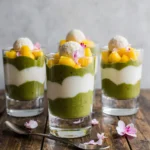
Japanese Mounjaro Dessert
Equipment
- small bowl for blooming gelatin
- saucepan to heat milk mixture
- whisk for stirring and mixing
- fine mesh sieve to strain the mixture
- ramekins or dessert glasses for serving
Ingredients
- 2 cups whole milk or mix of milk and cream
- 3 tbsp sugar (adjust to taste)
- 1.5 tsp unflavored gelatin powder or agar-agar
- 0.5 tsp vanilla bean paste or extract
- 1 pinch salt
- 0.25 cup coconut milk or cream (optional for variation)
- 2 tbsp yuzu juice or zest
- 2 tsp matcha powder (for green tea version)
- black sesame paste or crushed sesame seeds (optional)
- pureed mango or melon (optional for fruity layer)
- pistachio butter (optional for nutty twist)
Instructions
- In a small bowl, combine gelatin with 3 tbsp cold water. Let bloom for 5 minutes. If using agar-agar, skip this and add directly in next step.

- In a saucepan over medium-low heat, whisk together milk, sugar, salt, and vanilla. Heat until bubbles form at the edges (do not boil).
- Remove from heat and stir in bloomed gelatin until dissolved. If using agar-agar, simmer it in the milk mixture for 2–3 minutes.
- Divide the mixture into bowls if making different flavors. Stir in matcha, yuzu, coconut milk, or purées as desired.
- Strain each mixture through a fine mesh sieve into ramekins or glasses for a smooth finish.
- Refrigerate for at least 3 hours until set. For layered versions, chill each layer separately before adding the next.
- Before serving, garnish with red bean paste, fresh fruit, mochi, or black sesame shards.
Notes
Essential Ingredients for the Creamy Base
Classic custard base
The foundation of Japanese Mounjaro dessert is a light custard. You will need:
- Whole milk or a milk‑and‑cream blend (2 cups) – whole milk yields a creamy texture; adding cream makes it richer. Eggs are omitted for a lighter, no‑bake preparation.
- Sugar (about 3 tablespoons) – adjust to taste; start low and add more after tasting the warm mixture.
- Unflavoured gelatin or agar agar (1½ teaspoons) – gelatin gives a soft, elastic set; agar produces a firmer, vegan‑friendly gel. Gelatin must chill to set, while agar solidifies around 40 °C and does not require refrigeration ginobiotech.com.
- Vanilla bean paste or extract (½ teaspoon) – adds subtle sweetness.
- Pinch of salt – balances flavours.
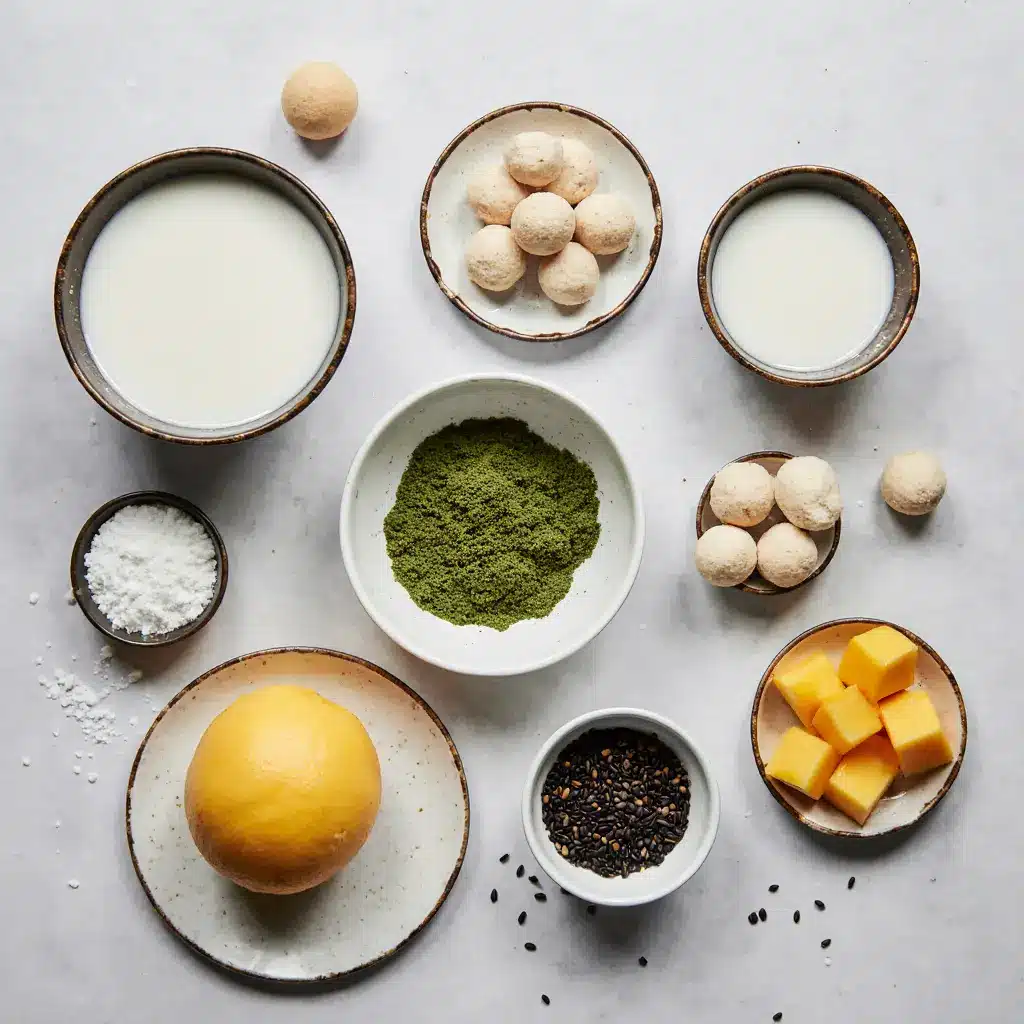
Gelatin and agar have different properties. Agar is made from red seaweed and creates a firmer gel; gelatin is an animal protein that yields a softer, more elastic texture ginobiotech.com. Choose gelatin for a classic wobble or agar for a vegan dessert. Gelatin must be bloomed in cold water before use; agar needs boiling to dissolve properly ginobiotech.com.
Dairy‑free alternatives
For a plant‑based dessert, replace dairy milk with full‑fat coconut milk, oat milk or almond milk. Coconut milk is particularly rich; it derives about 93 % of its calories from fat, mainly medium‑chain triglycerides (MCTs) healthline.com. Coconut milk also supplies vitamins and minerals such as manganese, iron and magnesium healthline.com. Although MCTs may modestly increase metabolism, the small amount in coconut milk is unlikely to affect weight significantly healthline.com. Oat milk and almond milk create a lighter texture but set well with gelatin or agar.
Flavouring options
Matcha
Matcha is a concentrated powder made from shade‑grown green tea leaves. The shading increases levels of phytochemicals and antioxidants health.harvard.edu. Matcha contains catechin antioxidants that may reduce blood pressure and LDL cholesterol health.harvard.edu, polyphenols with anti‑inflammatory effects health.harvard.edu and L‑theanine, an amino acid associated with improved concentration and alertness health.harvard.edu. Matcha powder adds a grassy, slightly bitter flavour and a striking green colour. Use 1–2 teaspoons whisked into a tablespoon of warm water to make a smooth paste before adding to the base.
Yuzu
Yuzu is a fragrant citrus fruit used widely in Japanese cuisine. It is high in vitamin C and contains flavonoids and carotenoids that act as antioxidants eatingwell.com. A 3.5‑ounce serving of yuzu juice provides about 59 % of the daily value for vitamin C eatingwell.com. Preliminary research suggests that yuzu aromatherapy can increase energy and reduce fatigue and anxiety eatingwell.com. Use freshly squeezed yuzu juice or zest for brightness; if unavailable, combine lemon and mandarin zest as a substitute.
Black sesame
Black sesame seeds have long been valued in East Asia. They are rich in polyunsaturated fatty acids, lignans and polyphenols news-medical.net and may reduce oxidative stress and insulin resistance news-medical.net. In a clinical trial, people consuming black sesame seeds showed a significant reduction in malondialdehyde, a marker of oxidative stress news-medical.net. Toasted black sesame seeds or paste lend a nutty flavour and dark colour; they pair particularly well with matcha.
Tropical fruits and other add‑ins
Purées of mango, melon or passion fruit provide natural sweetness and colour. Pistachio butter or almond butter adds richness and can be swirled between layers. For sweetness, consider raw honey, maple syrup or monk‑fruit sweetener. These ingredients complement the custard without overpowering the delicate flavours.
How to Make a Japanese Mounjaro Gelatin Dessert (Step-by-Step)
1 – Bloom the gelling agent
If using gelatin, sprinkle 1½ teaspoons of gelatin powder over 3 tablespoons of cold water and allow it to bloom for 5 minutes. For agar, measure 1 teaspoon and set aside; it will be whisked directly into the hot liquid.
2 – Heat and combine liquids
Pour 2 cups of milk (or milk‑cream mixture) into a saucepan with 3 tablespoons of sugar, a pinch of salt and ½ teaspoon of vanilla extract. Warm over medium‑low heat, stirring constantly until steam rises and small bubbles form at the edges. Do not boil – boiling can denature proteins and cause curdling. Using moderate heat and constant stirring helps maintain a silky texture.
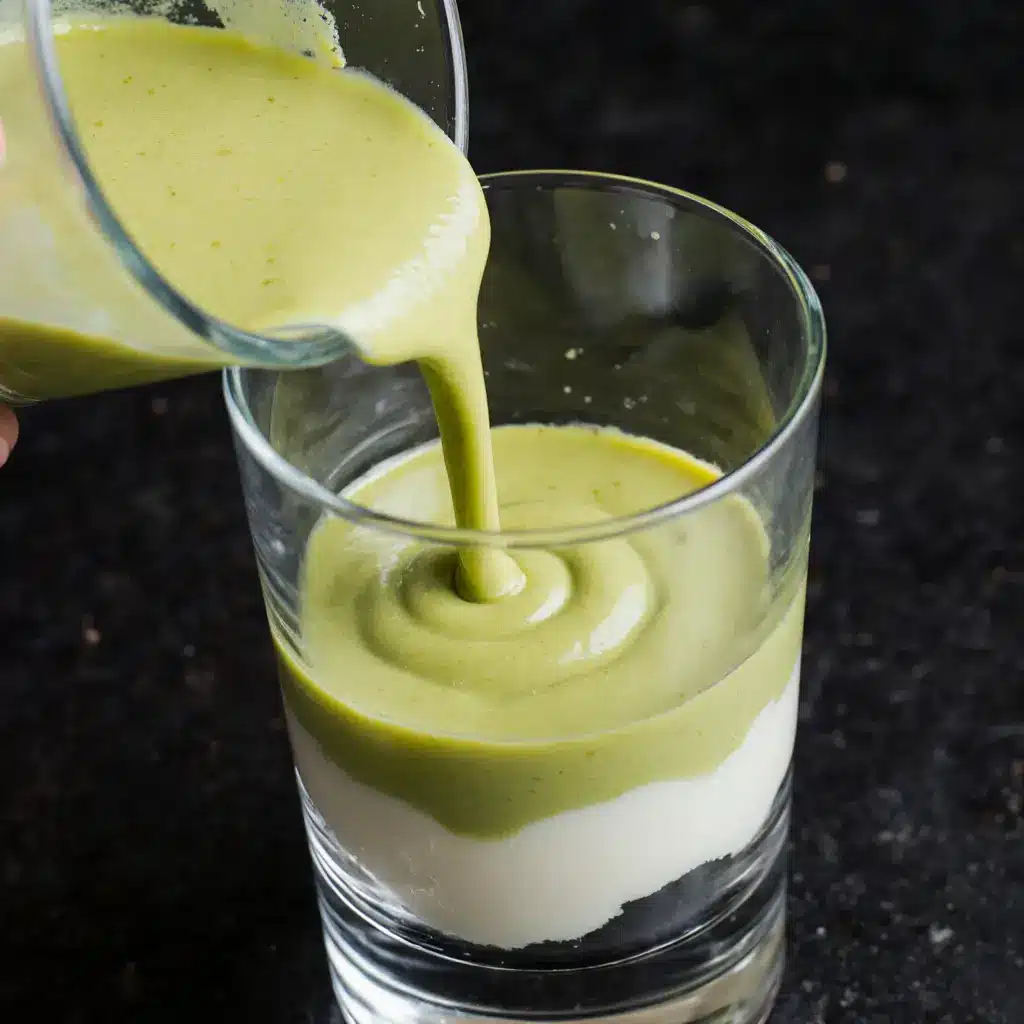
3 – Dissolve the gelling agent
Remove the pan from heat. Stir the bloomed gelatin into the hot liquid until completely dissolved. If using agar, whisk the powder into the simmering liquid and gently boil for 2–3 minutes to fully activate it ginobiotech.com. Once dissolved, allow the mixture to cool slightly before adding flavours.
4 – Incorporate flavours
Divide the warm base into separate bowls if making multiple flavours. Stir matcha paste, yuzu juice, coconut milk or fruit purée into each portion. Adjust sweetness with additional sugar or honey. To keep layers distinct, avoid mixing strongly acidic ingredients (such as citrus) into the base while it is hot; acid can curdle milk proteins.
5 – Strain and pour
Pour each flavoured mixture through a fine‑mesh sieve into ramekins or serving glasses. Straining removes any lumps of gelatin, agar or matcha and ensures a silky texture. For layered desserts, fill the first layer part‑way, then tilt the glass in a muffin tin so that the layer sets at an angle. Refrigerate for at least one hour before adding the next layer.
6 – Chill until set
Place the ramekins in the refrigerator and chill for at least 3 hours. Gelatin desserts must remain refrigerated to stay firm, while agar‑based desserts will set at room temperature but benefit from chilling for a smooth texture ginobiotech.com. The final custard should be firm but slightly jiggly when tapped.
Flavour Variations and Creative Twists
Matcha‑infused Mounjaro
This variation highlights the vegetal, slightly bitter notes of matcha. Whisk 1–2 teaspoons of high‑quality matcha with a tablespoon of warm water until smooth, then stir it into the custard base before straining. Matcha’s catechins and polyphenols may help lower blood pressure and LDL cholesterol health.harvard.edu and its L‑theanine content promotes alertness health.harvard.edu. The green colour contrasts beautifully with a pale coconut or vanilla layer. Garnish with a dollop of whipped cream or matcha‑flavoured mousse.
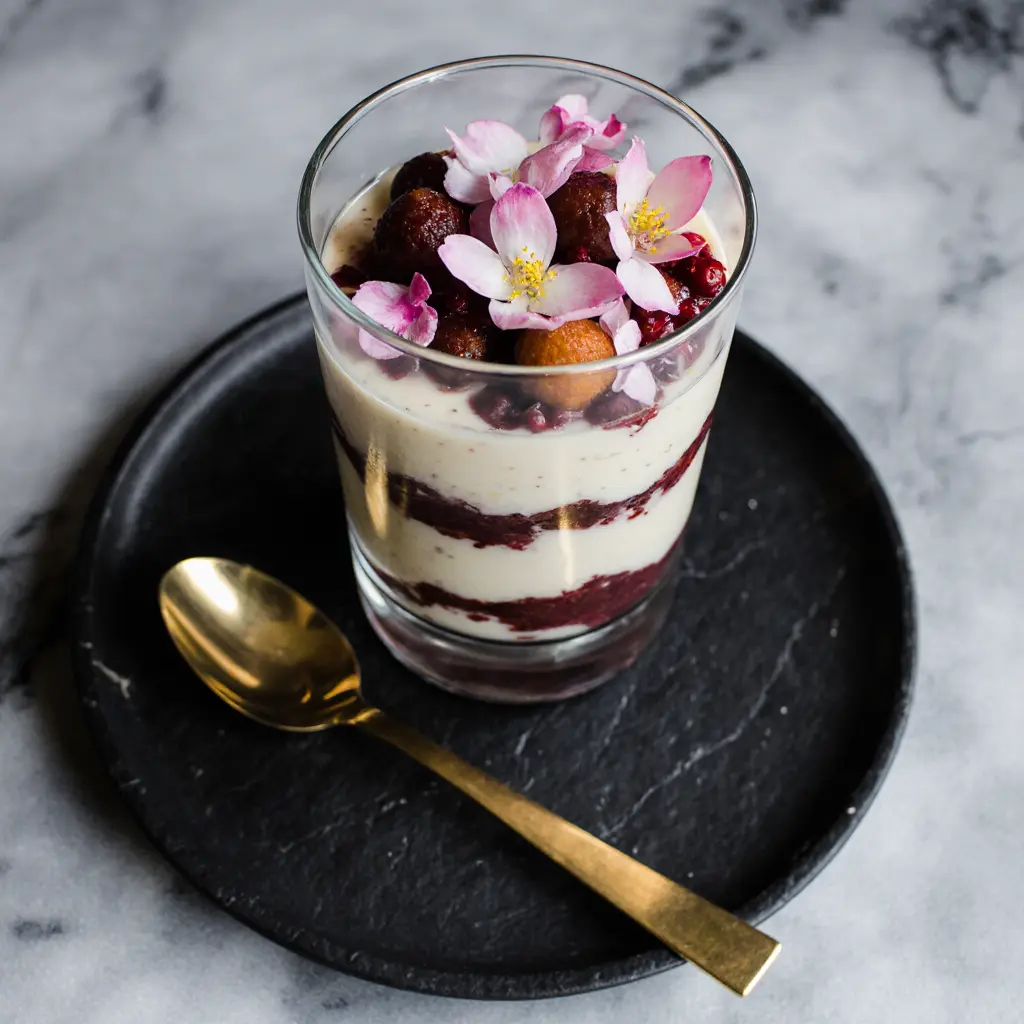
Yuzu–coconut twist
Swap ½ cup of milk for coconut milk and add 1 tablespoon of yuzu juice or ½ teaspoon of zest. Yuzu provides floral, citrusy brightness and a high dose of vitamin C eatingwell.com. Coconut milk adds creaminess and MCT‑rich fats healthline.com. Layer the yuzu‑coconut base with a mango or melon purée for a tropical look. Optional: top with a ribbon of toasted coconut for crunch.
Black sesame and pistachio
Stir 1 tablespoon of black sesame paste or a handful of finely ground toasted black sesame seeds into the warm custard base. The seeds supply antioxidants and may reduce oxidative stress news-medical.net, adding an earthy flavour. For a nutty layer, swirl in a teaspoon of pistachio butter or almond butter before pouring into ramekins.
Fruity tropical layers
Purée ripe mango or melon with a splash of coconut milk and a squeeze of lemon. Gently mix with the custard base for a naturally sweet layer. The bright colour of mango or melon creates a vivid contrast to matcha or sesame layers. Other options include passion fruit, lychee or strawberry purée.
Natural sweetener options
If you prefer to reduce refined sugar, sweeten your base with raw honey, maple syrup or monk‑fruit extract. Start with 1–2 tablespoons and adjust to taste. Honey and maple add a subtle flavour; monk‑fruit extract contributes sweetness without calories.
Assembly and Presentation
Layering techniques for visual impact
For diagonal layers, pour the first flavour into a glass and rest the glass at an angle in a muffin tin. Chill until firm, then return the glass to an upright position and pour the next layer slowly over the back of a spoon to avoid disturbing the set layer. Repeat for additional layers. Transparent glassware showcases the contrasting colours.
Glassware and molds
Use clear cups, jars or ramekins to highlight the layers. Purin molds are typically trapezoid‑shaped justonecookbook.com, but any glass or ceramic vessel works if it can hold ½ cup of liquid. For vegan versions using agar, small silicone molds allow easy unmolding because agar sets firmly and does not require refrigeration ginobiotech.com.
Garnish ideas
- Red bean paste (anko) – a spoonful of sweet azuki paste adds earthy sweetness and complements matcha.
- Mini mochi or shiratama dango – chewy rice dumplings provide textural contrast.
- Fresh fruit – mango cubes, melon balls, strawberries or kiwi slices give colour and freshness.
- Edible flowers or sakura petals – delicate floral notes pair nicely with yuzu or matcha.
- Black sesame shards – mix toasted sesame seeds with a little honey and coconut oil, spread thinly and let harden; break into shards for garnish.
- Pistachio butter drizzle – swirl a teaspoon of pistachio or almond butter over the top for a nutty finish.
High‑Competition Toppings and Mix‑Ins
Black sesame crunch and adzuki drizzle
To make sesame crunch, toast 2 tablespoons of black sesame seeds until fragrant. Stir in 1 teaspoon of honey and 1 teaspoon of coconut oil. Spread the mixture on parchment paper, let cool and break into shards. The antioxidants and polyphenols in black sesame may help reduce oxidative stress news-medical.net, and the nutty shards contrast nicely with the creamy base.
For an adzuki drizzle, thin sweet red bean paste with warm water or milk until pourable. Drizzle over the chilled dessert just before serving. The earthy sweetness of adzuki beans pairs well with matcha and sesame.
Fresh fruit and floral accents
Chill melon balls, mango cubes, strawberries or kiwi slices and arrange them on top. Their natural sweetness and juiciness brighten the dessert. For spring gatherings, garnish with sakura petals or edible flowers. Thin strips of yuzu or lemon zest add aroma and a burst of citrus oils.
Storage, Serving and Make‑Ahead Tips
Chilling and setting
Refrigerate the prepared dessert for at least 3 hours. If layering flavours, allow at least one hour between layers to ensure each layer sets before adding the next. Cover the ramekins with plastic wrap or lids to prevent condensation and odour absorption. Gelatin‑based desserts must be kept refrigerated; agar‑based desserts can stand at room temperature, but refrigeration improves the texture ginobiotech.com.
Serving suggestions
Serve the dessert chilled straight from the refrigerator. If it feels too cold, let it rest at room temperature for 5–10 minutes to soften. Avoid microwaving; high heat will melt the gel and ruin the texture. For a warm contrast, drizzle with heated adzuki sauce or pistachio butter before serving. Freezing is not recommended because ice crystals destroy the custard’s smooth texture.
Make‑ahead and portioning
Japanese Mounjaro dessert can be made up to three days in advance. Store individual servings in jars or lidded cups so guests can grab and enjoy without cutting. Do not freeze; instead, prepare fresh for best results.
Common Mistakes and How to Avoid Them
Preventing curdling
Curdling occurs when milk proteins coagulate due to high heat or acid. To avoid curdling:
- Heat milk slowly over medium‑low heat and remove when small bubbles form at the edges; do not boil.
- Stir constantly to distribute heat evenly.
- Add acidic ingredients like yuzu juice only after the mixture has cooled slightly.
- Strain the mixture through a fine sieve before chilling.
Controlling sweetness
Japanese desserts are typically modestly sweet. Start with 2–3 tablespoons of sugar per 2 cups of liquid and adjust to taste. Remember that toppings like red bean paste, mochi and fruit add additional sweetness. Consider using honey or monk‑fruit sweetener to lower the glycaemic load.
Choosing the right gelling agent
Gelatin produces a soft, creamy texture but must remain refrigerated. Agar yields a firmer, sliceable texture and sets at room temperature ginobiotech.com. You cannot substitute one for the other on a one‑to‑one basis because their textures, melting points and setting properties differ. If you want a vegan dessert, use agar; if you prefer a wobblier custard, use gelatin.
Japanese Mounjaro Variations at a Glance
| Variation | Key ingredients | Texture profile | Approx. prep time |
|---|---|---|---|
| Matcha Mounjaro | Matcha paste, custard base, optional mochi | Creamy with a slightly bitter edge | 20 minutes |
| Yuzu‑Coconut Mounjaro | Yuzu juice or zest, coconut milk, fruit purée | Light and tropical | 25 minutes |
| Black Sesame Mounjaro | Black sesame paste or seeds, custard base | Nutty and smooth | 20 minutes |
Frequently Asked Questions
What is Japanese Mounjaro dessert and how does it differ from other puddings?
Japanese Mounjaro dessert is a fusion pudding that takes inspiration from purin – a Japanese custard made with eggs, milk and sugar that has a silky, melt‑in‑the‑mouth texture justonecookbook.com. Unlike classic purin topped with caramel, this dessert combines flavours like matcha, yuzu and black sesame. It uses gelatin or agar instead of eggs, resulting in a lighter, no‑bake custard. It is unrelated to the viral weight‑loss drink that shares the name.
Can I make Mounjaro dessert without dairy or with vegan substitutes?
Yes, absolutely. Use full-fat coconut milk, oat milk, or almond milk with agar-agar instead of gelatin. It may set slightly firmer, but the flavor and creaminess remain excellent. For a flavor combo, see the coconut base tips in the Natural Mounjaro Recipe.
How long does Japanese Mounjaro dessert keep in the fridge?
When stored in a sealed container, gelatin‑based Mounjaro dessert retains its texture for up to three days. Agar‑based versions can be kept at room temperature, but refrigeration is recommended for the best texture. After three days, the custard may weep or lose firmness.
What fruits pair best with Japanese Mounjaro dessert?
Mango, melon, strawberries, kiwi and lychee are excellent choices. Their vibrant colours and juicy textures contrast with the creamy custard. Citrus segments or passion fruit also add brightness.
Is it possible to freeze Mounjaro dessert for later?
Freezing is not recommended. Ice crystals will disrupt the gel structure, causing a watery, grainy texture when thawed. Prepare the dessert fresh or within a few days of serving.
Does this dessert offer any health benefits?
The dessert is meant to be enjoyed as a treat. However, some ingredients have beneficial properties. Matcha contains catechins, polyphenols and L‑theanine that may support cardiovascular health and cognition health.harvard.edu. Yuzu juice is rich in vitamin C and antioxidants eatingwell.com. Black sesame seeds contain polyphenols and may reduce oxidative stress news-medical.net. Coconut milk provides minerals and MCT‑rich fats healthline.com. These benefits do not make the dessert a health food, but they add nutritional interest.
Can I adjust the texture?
Yes. For a softer, wobblier pudding, use less gelatin (about 1¼ teaspoons for 2 cups of liquid). For a firmer custard that can be unmolded, increase to 2 teaspoons or use agar. Remember that agar sets more firmly and at higher temperatures than gelatin ginobiotech.com.
Why is it called Mounjaro?
The name “Mounjaro” is a playful reference that has been used online for various recipes, including weight‑loss drinks and meals. In this context it simply labels a Japanese‑inspired dessert. There is no connection to the diabetes medication sold under the brand name “Mounjaro”; this dessert is purely culinary.
What is the Japanese Mounjaro gelatin dessert?
It’s a silky, no-bake pudding inspired by Japanese purin, made with milk, gelatin or agar, and flavoured with matcha, yuzu or black sesame. It’s unrelated to the Mounjaro drink.
Final Thoughts
Japanese Mounjaro dessert is a creative fusion of traditional purin with modern flavours like matcha, yuzu, coconut and black sesame. By mastering a simple gelatin or agar‑based custard, you can layer contrasting colours and textures into an elegant treat. While the ingredients offer intriguing nutritional properties—matcha’s antioxidants health.harvard.edu, yuzu’s vitamin C eatingwell.com, black sesame’s polyphenols news-medical.net and coconut milk’s MCTs healthline.com—the goal is pleasure, not therapy. Follow the step‑by‑step method, experiment with flavours and garnishes, and you’ll have a silky dessert that stands out from the viral drink fad and delights your guests.
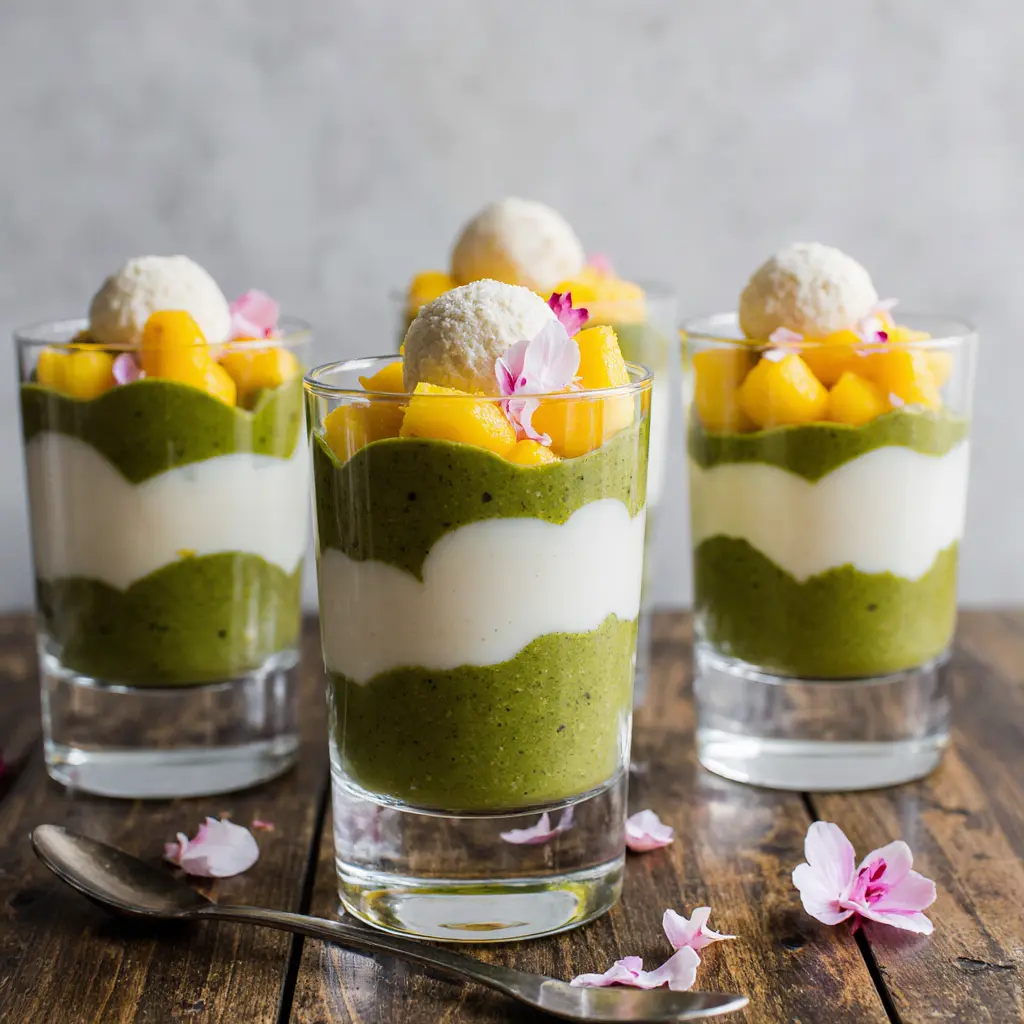
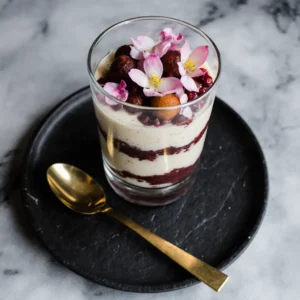





1 thought on “Japanese Mounjaro Gelatin Dessert Recipe – A Silky Purin-Style Matcha and Yuzu Pudding”